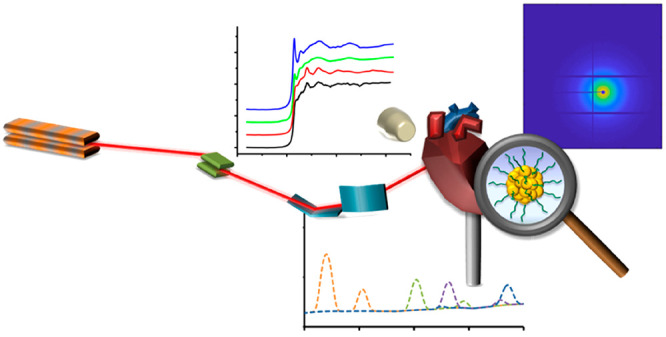[†
]Center
for Cooperative Research in Biomaterials (CIC biomaGUNE), Basque Research and Technology Alliance (BRTA) , Paseo de Miramon 182, 20014 Donostia San Sebastián, Spain
[‡
]Universitat
Rovira i Virgili , 43007 Tarragona, Spain
[§
]ICREA , Passeig Lluís
Companys 23, 08010 Barcelona, Spain
[∥
]Department
of Materials Science and Engineering, Stanford
University , Stanford, California 94305, United States
[⊥
]Mathematics,
Informatics, and Natural Sciences (MIN) Faculty, University of Hamburg , 20354 Hamburg, Germany
[⊗
]Centre
for Ultrafast Imaging, Universität
Hamburg , 22761 Hamburg, Germany
[#
]Department
of Chemical Engineering, University of Michigan , Ann Arbor, Michigan 48109, United States
[∇
]Biointerfaces
Institute, University of Michigan , Ann Arbor, Michigan 48109, United States
[○
]ARC
Centre of Excellence in Convergent Bio-Nano Science and Technology
and the Department of Chemical Engineering, The University of Melbourne , Parkville, Victoria 3010, Australia
[◆
]Deutsches
Elektronen-Synchrotron DESY , Notkestraße 85, 22607 Hamburg, Germany
[¶
]National
Center for Nanoscience and Technology (NCNST) , 100190 Beijing China
[□
]The
Molecular Foundry and Division of Molecular Biophysics and Integrated
Bioimaging, Lawrence Berkeley National Laboratory , Berkeley, California 94720, United States
[■
]Radiology
Department, University of Pennsylvania , Philadelphia, Pennsylvania 19104, United States
[◇
]School
of Chemistry and Chemical Engineering, Frontiers Science Center for
Transformative Molecules and National Center for Translational Medicine, Shanghai Jiao Tong University , Shanghai 200240, China
[●
]University College Dublin , D04 V1W8 Dublin, Ireland
[☆
]CAN, Fraunhofer Institut , 20146 Hamburg, Germany
[★
]Department
of Radiotherapy and Radiation Oncology, University Medical Center Hamburg-Eppendorf , 20246 Hamburg, Germany
[▲
]Department
of Radiotherapy and Radiation Oncology, University Medical Center Hamburg-Eppendorf , 20246 Hamburg, Germany
[▽
]Section
Biomedical Imaging, Department of Radiology and Neuroradiology, University Medical Clinic Schleswig-Holstein and Christian-Albrechts-University
Kiel , 24105 Kiel, Germany
[††
]Universität
Hamburg and Center for Free-Electron Laser Science , Luruper Chaussee 149, 22761 Hamburg, Germany
[‡‡
]Karolinska University Hospital, Huddinge, and Karolinska
Institutet , 17177 Stockholm, Sweden
[§§
]College of Engineering and Applied Sciences, Nanjing University , Nanjing 210093, China
[∥∥
]Terasaki Institute for Biomedical Innovation , Los Angeles, California 90049, United States
[⊥⊥
]Department of Materials Science and Engineering, University of Michigan , Ann Arbor, Michigan 48109, United States
[##
]Michigan
Institute for Translational Nanotechnology (MITRAN) , Ypsilanti, Michigan 48198, United States
[∇∇
]State Key Laboratory of Environmental Chemistry and Ecotoxicology,
Research Center for Eco-Environmental Sciences, Chinese Academy of Sciences , Beijing 100085 China
[○○
]Ikerbasque, Basque Foundation for Science , 48013 Bilbao, Spain
[◆◆
]Centro de Investigación Biomédica
en Red de Bioingeniería,
Biomateriales y Nanomedicina (CIBER-BBN) , Paseo de Miramon 182, 20014 Donostia-San Sebastián, Spain
[¶¶
]European XFEL , 22869 Schenefeld, Germany
[□□
]Department of Chemistry and Physics, La
Trobe Institute for Molecular
Science, La Trobe University , Melbourne 3086, Victoria, Australia
[■■
]Sektion Physik, Ludwig Maximilians Universität
München , 80539 München, Germany
[●●
]Saha Institute of Nuclear Physics , Kolkata 700064, India
[☆☆
]Department of Chemistry, Department of Chemical Engineering,
and
Materials Research Institute, The Pennsylvania
State University , University Park, Pensylvania 16802, United States
[★★
]Department of Radiology, German Cancer
Research Center (DKFZ) , 69120 Heidelberg, Germany
[△△
]Department of Physics, University
of Wisconsin-Milwaukee , 3135 N. Maryland Avenue, Milwaukee, Wisconsin 53211, United States
[▲▲
]Department of Physics, Indian Institute
of Science , Bangalore 560012, India
[▼▼
]California NanoSystems Institute, University
of California, Los Angeles , Los Angeles, California 90095, United States
[†††
]Department of Materials Science and Engineering, University of California, Los Angeles , Los Angeles, California 90095, United States
[‡‡‡
]Molecular Science and Biomedicine Laboratory (MBL) State
Key Laboratory of Chemo/Biosensing and Chemometrics College of Chemistry
and Chemical Engineering, Hunan University , Changsha 410082, P.R. China
[§§§
]Institute of Molecular Biology of National
Academy of Sciences of
Republic of Armenia , 7 Hasratyan str., 0014 Yerevan, Armenia
[⊥⊥⊥
]CANDLE Synchrotron Research Institute , 31 Acharyan str., 0040 Yerevan, Armenia
[###
]Department
of Chemistry and Biochemistry, University
of California, Los Angeles , Los Angeles, California 90095, United States
[∇∇∇
]Department of Bioengineering, University
of California, Los Angeles , Los Angeles, California 90095, United States
[○○○
]Bioimaging Center, Shanghai Synchrotron Radiation Facility,
Zhangjiang Laboratory, Shanghai Advanced Research Institute, Chinese Academy of Sciences , Shanghai 201210, China
[◆◆◆
]Division of Physical Biology, CAS Key Laboratory
of Interfacial
Physics and Technology, Shanghai Institute of Applied Physics, Chinese Academy of Sciences , Shanghai 201800, China

